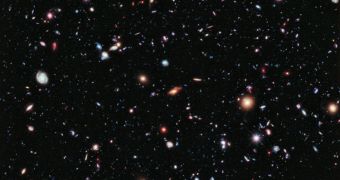A team of astronomers recently announced the completion of the deepest-ever view of the Universe. The dataset was obtained by combining 10 years' worth of information collected by the NASA/ESA Hubble Space Telescope.
The investigation, called eXtreme Deep Field (XDF), is in fact a new and heavily improved version of the original, more famous Hubble Ultra Deep Field (UDF) survey. The former covers a smaller area than the latter, but provides more accuracy and detail.
According to experts, the UDF analyzed a small patch of sky in the constellation Fornax between 2003 and 2004, snapping long-exposure photographs of the distant Universe. This enabled faint light from very distant objects to reach the telescope's detectors.
In other words, the first deep-field survey produced amazingly detailed images even if it only used data collected over 2 years. Therefore, the full-color XDF survey has the potential to provide up to five times more information, scientists say.
Though it has a smaller field of view than UDF, XDF is a lot more sensitive, and was thus able to detect more than 5,500 galaxies in this narrow patch of sky. The faintest of these objects are only 10 billionths the minimum brightness that the human eye can detect.
“The XDF is the deepest image of the sky ever obtained and reveals the faintest and most distant galaxies ever seen. XDF allows us to explore further back in time than ever before,” explains University of California in Santa Cruz (UCSC) expert, Garth Illingsworth.
He was the principal investigator of the Hubble Ultra Deep Field 2009 (HUDF09) program. The farthest galaxies the XDF survey detected are located 13.2 billion light-years away, which means that we see them as they looked just 550 million years after the Big Bang.
The Hubble Advanced Camera for Surveys (ACS) and the Wide Field Camera 3 (WFC-3) are the main instruments used to collect this batch of data. Between themselves, they registered more than 2 million seconds of exposure time,
Starting in 2018, the XDF survey will be continued by the NASA James Webb Space Telescope, which is billed as Hubble's successor. The observatory will have the most sensitive detectors ever deployed to space, and infrared capabilities second to none.

 14 DAY TRIAL //
14 DAY TRIAL //